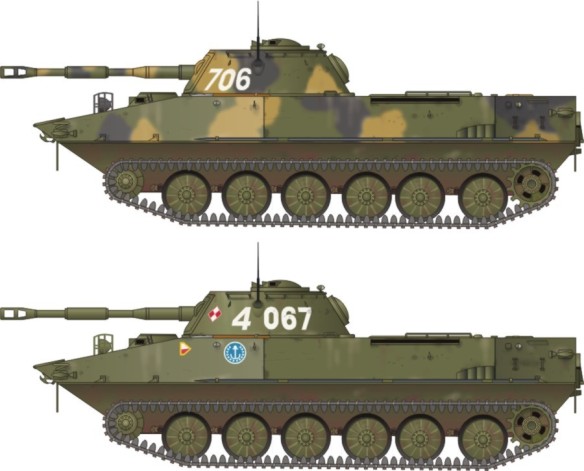North Vietnamese PT-76A, battle of Ben Het 1969.
The PT-76 is a Soviet amphibious light tank which was introduced in the early 1950s and soon became the standard reconnaissance tank of the Soviet Army and the other Warsaw Pact armed forces.
The tank’s full name is Floating Tank–76. 76 stands for the caliber of the main armament: the 76.2 mm D-56T series rifled tank gun.
The PT-76 is used in the reconnaissance and fire-support roles. Its chassis served as the basis for a number of other vehicle designs, many of them amphibious, including the BTR-50 armored personnel carrier, the ZSU-23-4 self-propelled antiaircraft gun, the ASU-85 airborne self-propelled gun and the 2K12 Kub anti-aircraft missile launch vehicle.
The Soviets developed the PT-76 light tank. It had no equivalent in the NATO armies. As large as an MBT, the PT- 76 was, however, thinly armored and was developed chiefly to lead amphibious assaults and conduct reconnaissance. Easily identifiable by its pointed nose and low, round turret with sloped sides and flat roof, the PT-76 was designed to be an amphibian without any preparation. Its powerful engine was adequate for both land and water propulsion, with movement through water accomplished by means of water jets from the rear of the hull. The PT-76 weighed about 32,000 pounds, had a crew of three, a 140-hp engine that produced a maximum speed of 28 mph, and was armed with a 76.2mm (3- inch) main gun and one machine gun.
PT-76 tank design
The tank has a welded steel hull with three compartments. The driver sits in the front compartment and has a single-piece hatch cover. The tank has an all-welded steel turret with seating for the commander on the left and loader on the right. The tank has 15mm thick armour made up of homogeneous, cold rolled, welded steel. An oval shaped hatch cover is fitted to the turret with a vertical lock. A circular cupola on the double hatch allows for the use of observation devices. An emergency hatch is also provided under the driver’s seat for crew exit.
A trim vane at the front provides stability during in-water operations and acts as additional armour when not in use. It protects the crew and ammunition against small artillery shell fragments and 7.63mm arms fire
Development and upgrades
The tank was developed for the Russian Army to meet their requirement of an amphibious light reconnaissance tank after the World War II. It was developed along with an armoured personnel carrier (APC), BTR-50P, and they share common automotive and suspension systems. The first prototype was developed in 1950 and after further trials and improvements it entered into service in 1952. The variant PT-76B was the final production model of the tank built at the Volgograd Tractor Plant.
It underwent several upgrades in service such as addition of a gun stabiliser, a TDA smoke generator system, FVU and PAZ systems and an R-113 VHF radio. The upgraded tank features a 90mm defence gun from CMI of Belgium and a new diesel power pack developed by Nimda of Israel.
The state intermediary agency JSC Rosoboronexport of Russia also provided an upgrade package for the chassis and turret of the tank. The new turret is equipped with an AU-220M, a two-person 57mm rapid fire weapon system. The automatic 57mm cannon is fully stabilised and has a muzzle brake to reduce its recoil force on the chassis.
Easily identifiable by its pointed hull front and round turret with sloping sides and flat roof, the PT-76 was developed after World War II to lead amphibious assaults and for reconnaissance. It entered Soviet service in 1955 and was replaced by either MBTs or specialized versions of the BMP-1/BMP-2. The People’s Republic of China produced an improved version with a new turret and 85mm gun. The PT-76 is probably the longest-lived AFV still in regular service.
The PT-76 entered service with the Soviet Army and Naval Infantry reconnaissance units in 1955 (three to five per company) and continued in service until 1967. It saw wide use in the armies of Soviet bloc countries and also was utilized by Afghanistan, Benin, Cambodia, Congo, Croatia, Cuba, Guinea, Guinea-Bissau, Indonesia, Iraq, Laos, Madagascar, Nicaragua, North Korea, North Vietnam, Uganda, Yugoslavia, and Zambia. South Vietnamese and U. S. forces encountered the PT-76 during the Vietnam War. It also fought in the 1964 India-Pakistan War and in various conflicts in Africa. Popular because it offers excellent characteristics, reliability, and low cost, the PT-76 continues in wide service today.
Production dates: 1952–1967
Number produced: Approximately 7,000
Manufacturer: Soviet state factories
Crew: 3
Armament: 1 x 76.2mm main gun; 1 x
7.62mm machine gun (coaxial)
Weight: 32,178 lbs.
Length: 22’8”
Width: 10’4”
Height: 7’3”
Armor: 17mm maximum; 5mm minimum
Ammunition storage and type: 40 x
76.2mm; 1,000 x 7.62mm
Power plant: Model V-6B inline-6 240-hp water-cooled diesel engine
Maximum speed: 28 mph
Range: 174 miles (40 miles in water)
Fording depth: amphibious
Vertical obstacle: 3’1”
Trench crossing: 9’2”
Special characteristics (pos/neg): infrared for driver, but no NBC
Special models: The PT-76 has been the platform for many variants.
